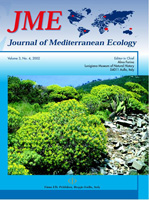JME 2002 4
Philip K. Groom
Effects of water stress on xylem water potential, stomatal conductance and growth were assessed experimentally on 7-month-old seedlings of Banksia menziesii R.Br. (Firewood Banksia) and Banksia littoralis R.Br. (Swamp Banksia) (Pro-teaceae) grown in 1 m deep tubes filled with course sand and subjected to 140 days of drought. Both are tree species ofthe sandplains of mediterranean southwestern Australia. B. littoralis is restricted to low-lying, winter damp areas, inclu-ding the fringe of seasonal and permanent wetlands, whereas B. menziesii inhabits a range of habitats ranging from mid-upper slopes of deep, sandy dunes to dune crests. It was hypothesised that differences in their water relations and growthresponses would reveal drought adaptation attributes that relates to their contrasting habitat preferences. For both spe-cies drought caused significant decreases in stomatal conductance and predawn xylem water potential. B. menziesiiseedlings had a low stomatal conductance (< 0.1 mol m-2 s-1) and exhibited a desiccation avoidance response to droughtby maintaining relatively higher water potential. In comparison, B. littoralis seedlings sustained higher stomatal con-ductance (0.2-0.3 mol m-2 s-1), until volumetric soil moisture content decreased to approximately 2%, avoiding droughtby means of desiccation tolerance. Drought affected B. littoralis seedlings had lower relative growth rates (based onshoot dry weight) than well-watered controls. For B. menziesii there was no difference in relative growth rates betweencontrol and drought affected seedlings. Overall the two Banksia species displayed drought responses consistent withtheir current habitat preferences.
Keywords: Banksia, drought tolerance, sandplain, soil moisture content, stomatal conductance, water stress
Effect of seed shape and size on their distribution in the soil seed bank
Pérez-Fernández María A., Gómez-Gutiérrez José Manuel, Martín-Berrocoso Ana and Mann Reinier
Endemic to the NW part of the Iberian Peninsula, Cytisus multiflorus has various reproductive and germinative strate-gies. Its seeds show a high degree of polymorphism, which can affect their location at different depth in a persistent soilseed bank. This paper puts forward a hypothesis that the dimensions and weight (shape and size) of Cytisus multiflorusseeds may be responsible for their vertical distribution in the soil seed bank. This hypothesis was tested and severalanomalies and deviations were found that could be explained when considering the history of land use, such as tilling,grazing, or the activity of seed predators.
Keywords: Soil seed bank, seed morphology, Cytisus multiflorus.
D. Sirkou, C. L. Alados, V. P. Papanastasis, M. S. Vrahnakis, K. Iovi, M. L. Giner and I. Ispikoudis
In this study we used developmental instability expressed as translational and fluctuating asymmetries as well as fractaldimension in order to assess the effects of different levels of grazing pressure by goats on two dominant species ofMediterranean shrublands, i.e. Phillyrea latifolia L., a palatable, and Cistus monspeliensis L., an unpalatable shrub.Treatments included light, moderate and heavy grazing pressure. For the former species, an additional ungrazed treat-ment was used as a control. Measurements were carried out in thirty shrubs of each species in each treatment. ForPhillyrea, the fluctuating asymmetry analysis revealed higher asymmetry of leaves in the grazed treatments than in thecontrol. The lower parts (below 1.5m height) of Phillyrea shrubs, reached by goats, also attained larger values of asym-metry in comparison to the upper parts (above 1.5m height) of the shrubs, not reached by goats. Moreover, fractaldimension of branches was lower in the grazed treatments in comparison to the ungrazed ones, as well as in the lowerparts compared to the upper parts of the shrubs. However, the results of translational asymmetry analysis showed thatgrazed shrubs were developmentally more stable than the ungrazed ones. These results suggest that Phillyrea is verytolerant to grazing; its upper part can be maintained in a non – stressful situation even when its lower part is overgrazed.For Cistus, the results of translational asymmetry revealed that grazing did not affect its developmental stability. Theeffects of grazing on fractal dimension declined under moderate grazing situations. This indicates that Cistus is develop-mentally stable both in well preserved and in heavily disturbed sites. It is concluded that developmental instability andfractal dimension are useful tools in assessing the differential response of Mediterranean key species to grazing impact.
Keywords: fluctuating asymmetry, fractals, goats, grazing, Mediterranean shrublands, translational asymmetry.
Martins, H. Miller, D.R. Elston, D.A. Rego, F. & Milne, J. A.
The importance of environmental variables related to vegetation, soils and topography on the distribution and number ofentrances of wild rabbit warrens was investigated in a Mediterranean savannah-like ecosystem (montado in southernPortugal). Warren locations were obtained using the line transect method. Each warren was mapped on an orthophoto-map and characterised in terms of total number of entrances. Estimates of warren density and average number of entran-ces were obtained, using Distance 3.5 software, for five different vegetation types – arable crops, pastures, tall scrub,average scrub and low scrub. Environmental variables were also measured at each warren location, either at the site orusing GIS functions. These included distance to the nearest tree and percentage of vegetation cover, landscape diversity,exposure and slope. The importance of vegetation and environmental variables on warren location was assessed bycomparison with random points within generalised linear models, allowing for bias due to detectability.The importance of vegetation type and structure on warren location and the number of entrances, in terms of providingprotective cover and feeding areas, was demonstrated. Warrens were more abundant in dense scrub vegetation and theirlocation was positively correlated with height and percentage of scrub cover in the proximity, landscape diversity, treecover and presence of a tree. The number of entrances was positively correlated with the tree diameter at 1.30 m (d.b.h.).The presence of trees was demonstrated as contributing significantly to the suitability of montados for wild rabbits. Theresults are discussed in relation to habitat management strategies for increasing or maintaining wild rabbit populations.A strategy of maintaining patches of dense scrub interspersed with areas of open vegetation is advocated.
Keywords: warren density, line transect, Distance 3.5, vegetation type, habitat use, habitat management
